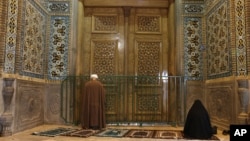The scientific basis of medicine can be traced to Hippocrates’ rejection of disease as having a divine origin. His work has been dismissed before – by the feudal kings of fourteenth century Europe – and is repudiated again today by elements of the Iranian regime. Long forgotten leaders of church and state once directed people toward prayer to ward off the Black Plague. That failed. And so too will the Islamic Republic’s theocratic and conspiracy-laced approach to combating COVID-19.
The holy city of Qom – where workers were seen last month digging mass graves – is at the center of both the pandemic in Iran and the regime’s initial resistance to ordering travel restrictions or quarantines. Qom is the philosophical and academic home of the Shiite sect and home to the most influential clerical seminaries in the country. The first cases of the coronavirus were reportedly introduced there by Chinese seminary students at Al-Mustafa International University.
Despite urgent advice from leading epidemiologists and Qom’s representative in the Iranian parliament the regime leadership refused to enforce an immediate city-wide quarantine, and Qom remained open.
Taken further, on February 26, President Hassan Rouhani, a cleric himself, went on national television and rejected all calls to close Qom. The level of dissatisfaction with the regime’s performance became so acute, that five former health ministers wrote a public letter to Rouhani urging travel limitations. Only days later did the regime—reluctantly—begin to take such steps.
Elsewhere, radical clerics rejected calls by the Health Ministry to close shrines, making absurd proclamations that the shrines are not only immune to any pandemic, but also that they heal those afflicted with the virus. The rejection of modern science-based medicine has been part of a decades-long clerical anti-Western narrative. Some went further, advocating for a concocted alternative “Islamic Medicine.”
In January, the so-called “Father of Islamic Medicine” publicly burned a copy of a widely used medical textbook for students and clinicians in his effort to promote Islamic Medicine. In the midst of the coronavirus pandemic, supporters were urged to “cure” the virus by using violet oil. These actions inevitably have and will continue to exacerbate the spread of the virus.
The Islamic Republic also has a history of using djinns, or religious, supernatural forces, for political ends—for example, allies of then-President Mahmoud Ahmadinejad were arrested in 2011 and accused of black magic due to the challenge they represented to the foundations of Iran’s theocratic system. Recently, Ayatollah Khamenei has used the supernatural to explain away the coronavirus and to demonize the West. In his speech on the occasion of the Persian New Year, referring to the pandemic in Iran, he said: “We have djinn and human enemies that help each other. The intelligence services of many countries work together against us.”
In the same speech, Khamenei refused U.S. assistance to fight the outbreak, pushing a conspiracy theory that the virus was a weapon designed by America. He also alleged that the virus could have been “specifically designed for Iran using the genetic data of Iranians which they have obtained through different means.” On cue, the Ministry of Health rescinded its approval for an intervention by Doctors Without Borders the day after Khamenei’s speech, a move that certainly exacerbated the severe coronavirus cases the organization would have helped temper.
What has transpired in Iran over the past few weeks is testament to the regime’s failure in the face of a national emergency. And there is little hope that the regime will change course in the weeks and months ahead. The Islamic Republic’s recalcitrance has left nearly 80 million Iranians largely helpless and once again confronted with living in a theocracy, which has prioritized its own survival and religious underpinnings, like medieval Europe, at the expense of the Iranian people.
Seven hundred years ago, the Renaissance was born in the wake of the Black Plague, ushering in unprecedented advances in science and technology. Perhaps the coronavirus will lead ultimately to Iran’s own renaissance, but only at great cost.







